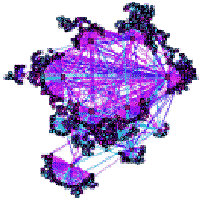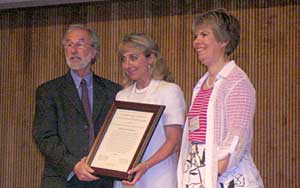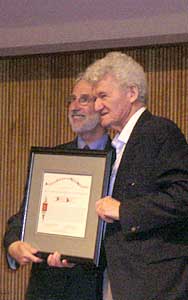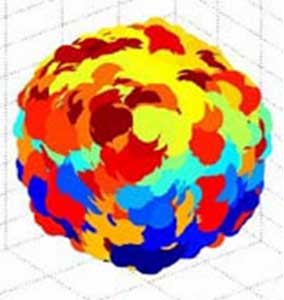
The 2006 SIAM Annual Meeting
 |
| Approximately 1100 people attended the 2006 annual meeting of the Society for Industrial and Applied Mathematics (SIAM) at the Park Plaza Hotel in Boston, July 10-14. Below are descriptions of some of the events that took place at the meeting. |
Complex Networks: From the Internet to Biology, Albert-László Barabási, University of Notre Dame
|
In the first plenary lecture of the meeting, Barabási gave examples of networks, from the cell to the Internet, and spoke about some of their properties. Although networks like the World Wide Web may seem random, in fact they obey a power law distribution in that the probability that a node has a given number of connections is close to k-r (where k is the number of connections) for some value of r. Fortunately, these networks can survive random attacks but cannot survive the disabling of hubs (nodes with many connections). One crucial question that researchers are trying to solve: How does the structure of a network affect its function? (Image: Hierachical topology of the international web cache |
Robust Optimization in Cancer Treatment Planning, Stephen J. Wright, University of Wisconsin
Wright spoke about optimizing radiation therapy for cancer. Ideally, radiation should be delivered only to the tunor, but in practice radiation has to go through healthy tissue to reach the tumor. Thus, planners design treatments to minimize damage to critical regions of the body while maximizing the damage to tumors. Wright showed how a radiation beam is broken up into smaller components, called beamlets. Then a dose matrix is created in which the (i, j )-th entry is the amount of radiation to be delivered by the i- th beamlet to the j- th position. Unfortunately, the following all lead to error: uncertainty in the dose matrix, alignment and movement of the patient, and movement of the patient's organs. Because of the error, a robust method is needed which will result in the prescribed treatment. The method Wright discussed assigns weights to a beamlet vector so that important constraints are satisfied for most dose matrices. The method uses sequential linear programming to choose the dose matrix.
Exploring Cytoskeletal Dynamics via Computer Simulation, Gary Odell, University of Washington
Odell's plenary lecture was about modelling some cell dynamics in C. elegans (a nematode), specifically the action of microtubules, thousands of which grow, die and regrow every minute in our cells as well as those in C. elegans. In C. elegans ' egg cells, the male and female pronuclei start at opposite ends of the cell but are pulled to the middle of the cell by motor proteins. Microtubules, initially attached to the male pronucleus, grow throughout the cell but stop growing when they hit the cell wall. Researchers would like to know why this happens. Odell noted that if the microtubules didn't stop growing our cells would look like sea urchins, inundated with microtubules. He thinks that a substance known as CLIP170 along with the angle at which a microtubule hits the cell wall explain what halts the growth. His model involves almost 200,000 differential equations that change and have to be solved at each designated time interval.
Prizes and Awards Luncheon
SIAM President Martin Golubitsky hosted this luncheon and handed out the following prizes and awards:
- I.E. Block Community Lecture : Simon A. Levin, Princeton University
- Julian Cole Lectureship : Michael J. Shelley, Courant Institute of Mathematical Sciences, New York University
- George B. Dantzig Prize : Éva Tardos, Cornell University
- Richard C. DiPrima Prize : Xinwei Yu, California Institute of Technology
- Assocation for Women in Mathematics-SIAM Sonia Kovalevsky Lecture : Irene Fonseca, Carnegie Mellon University (pictured above)
- Lagrange Prize in Continuous Optimization : Roger Fletcher, University of Dundee (Scotland), Sven Leyffer, Argonne National Laboratory, and Philippe L. Toint, University of Namur (Belgium)
- George Polya Prize : Gregory F. Lawler, Cornell University, Oded Schramm, Microsoft Corporation, and Wendelin Werner, Université Paris-Sud (France)
- W.T. and Idalia Reid Prize : Peter Kloeden, Johann Wolfgang Goethe University (Germany)
- SIAM Activity Group on Analysis of Partial Differential Equations Prize : François Golse, Université Paris VII - Denis Diderot (France) and Laure Saint-Raymond, Université Pierre et Marie Curie (France)
- SIAM Award in the Mathematical Contest in Modeling : Continuous Problem: Brian Camley, Pascal Getreuer, and Bradley Klingenberg (students), Bengt Fornberg (faculty advisor), University of Colorado at Boulder ; Discrete Problem: Benjamin Conlee, Neal Gupta, and Christopher Yetter (students), Clifford H. Taubes (faculty advisor), Harvard University
- SIAM Outstanding Paper Prizes : Girish N. Nair and Robin J. Evans, University of Melbourne (Australia); Jean-Michel Coron and Emmanuel Trélat, Université Paris-Sud (France); Michael Hintermüller, University of Graz (Austria), Kazufumi Ito, North Carolina State University, and Karl Kunisch, University of Graz
- SIAM Prize for Distinguished Service to the Profession : Peter D. Lax, Courant Institute of Mathematical Sciences, New York University (pictured below)
- SIAM Student Paper Prizes : Laurent Demanet, California Institute of Technology, Emanuele Viola, Harvard University, and Hongchao Zhang, University of Florida
- The John von Neumann Lecture : George Papanicolaou, Stanford University
Collective Motion and Decision-Making in Animal Groups, Iain Couzin, University of Oxford
What's Math Got to Do with It?, David Keyes, Columbia University
Some myths about mathematics are that it is terrifying, static, aloof from other sciences, solitary, and not a practical major for career preparation. Keyes disuputed these myths in his lecture and made an interesting analogy: Just as English is spoken by many more non-native speakers than native, mathematics is used daily by more non-mathematicians than mathematicians. Some of the applications of mathematics that Keyes discussed are finance, modeling forest fires, and algorithms to download web pages faster. He concluded with a quote from Philippe Toint on the importance of good algorithms: "I would rather have today's algorithms on yesterday's computers than vice versa."
I.E. Block Community Lecture: Individual Choice, Cooperation, and the Global Commons, Simon Levin, Princeton University
|
In this lecture open to the public Levin presented some important challenges, such as pollution and the depletion of fisheries, that humanity is faced with. He made no claim to have answers, but said that the economic and ecological problems he talked about need new mathematical approaches to solve them. The tragedy of the commons is that with a resource available to all, such as an aquifer, the greediest can gain in the short term while mutual ruin is just around the corner. Levin also examined cooperation and game-theoretic experiments to explain it. He concluded by noting mathematics' contribution to solving problems such as population growth and the spread of disease, but said that now mathematics should be applied to understanding human behavior. |
Diversity, Innovation and our Scientific and Technological Workforce, Richard Tapia, Rice University
Tapia begain his plenary lecture by giving some of his own history which began as an increasing function: His high school was bad, the community college he attended was good, and UCLA was great. Nationwide in the 1970s less than 3% of science, technology, engineering and mathematics degrees were awarded to Blacks and Hispanics. Now that figure is about 6%, but the two groups make up about 30% of the U.S. population. Increasing admissions of minorities is important, but Tapia feels that retention and placement are much more important. He also said that society still tells minority students that they don't belong in careers in science and mathematics. Near the end of his lecture, Tapia talked about a dramatic success story in which a group of D high school students from Carl Hayden Community High School in Phoenix won a national robotics competition against colleges and universities.
Increasing the Number of Minority Ph.D.'s, David Manderscheid, University of Iowa
In a session following Tapia's talk (above), Manderscheid spke about what the University of Iowa Department of Mathematics has done to recruit and retain underrepresented minority students. Whereas Iowa's population is about 5% underrepresented minority, the percentage of underrepresented minorities in the graduate program is more than four times that figure. His department expands its pool of applicants ("If you use the same criteria you've always been using, you'll probably get the same students."), has an extensive mentoring program with an emphasis on community, and expects every student to succeed. The department make multi-year offers to graduate students and tries to get students into active research as soon as possible. As a result, courses are now harder than they used to be. This past year, all 12 students who visited the university eventually enrolled.
Multiscale Model for Cancer Development, Yi Jiang, Los Alamos National Laboratory
A description of the 2005 SIAM annual meeting with links to descriptions of previous SIAM annual meetings is also available. Due to the quadrennial International Congress on Industrial and Applied Mathematics in Zurich, there will be no 2007 SIAM annual meeting.
Photos and text by Mike Breen, AMS Public Awareness Officer










